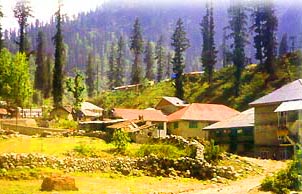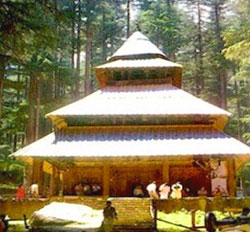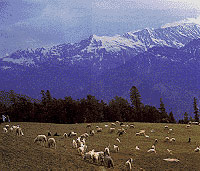|
Travelogues Return to Manali
|
|||||||||||||||||||||
Three years now I have found myself seemingly retracing my steps back to Manali, without being acutely aware of exercising choice in returning here. The road from Delhi to Ambala, 45 kms from Chandigarh, is now a 4-lane highway that makes for a pleasurable 5th gear cruise for the most part. Past Mohali, Ropar and Bilaspur, we stop the night at the PWD rest house in Sunder Nagar, to reach Manali the next day at noon. October is a great time of year to be arriving here. A perfect autumn afternoon, no tourists milling the Mall, I can unselfconsciously establish roots to a tenuous link of belonging that owe its origins to two brief but immeasurably enjoyable holidays here. |
More About Himachal • At a Glance
Travelogues
Impressions
Trekking | ||||||||||||||||||||
Young and enthusiastic, Jitender and Neeraj Thakur are running the place with great involvement. Jitender, a hotel management graduate is passionate about his personal computer and the internet, while Neeraj is an outdoor enthusiast, crazy about bikes who is starting his own trekking activities. Both brothers went that extra mile to make our stay the way we wanted it to be.
Johnson's Café towards the Circuit House, is a popular, pricey garden café and restaurant, ideal for an afternoon beer and fresh grilled trout. Il Forno Pizzeria, on the Hadimba Temple road, is an old rustic stone and wood building within which is served authentic Italian food. Shere Punjab on the Mall, offers spicey North Indian food at very reasonable rates. Mount View Restaurant, also on the Mall, is a great place for Chinese and Tibetan fare. The Fall Out Bar in Banon's Resort, beyond the Circuit House, is popular, particularly with foreigners missing the action of bars and pubs on week-ends. Swamiji's Madras Café in a lane adjoining Punjab National Bank on the Mall, offers reasonable South Indian fare and a thali for Rs 35. In the same lane, Mayur's offers a great tandoori trout for Rs 80 and has a wide choice of menu.
Manali is an ideal starting point for varied treks in this region. Depending on your skill, experience and inclination, you can choose brief, easy or moderate treks amidst meadows, sparkling brooks and dense forests, or a high altitude trek over awesome, stark, barren landscapes for several days. This time round in Manali, one of the first people I visit is Tanzin Negi, one of the partners of Shambala, who had accompanied us on our trek to Deo Tibba base last year. He greets us with the warmth and openness so typical of people living in the hills. His office becomes a frequent port of call on the way back from collecting the newspaper. The Hadimba temple is a stone's throw away from Devi Dyar Hotel. The 450 year old Dhoongri temple is dedicated to the goddess Hadimba, the local deity who is worshipped for protection. It is believed that Bhim, the mighty Pandava of the Mahabharat married Hadimba, after slaying her brother, the demon Hadimb. The temple is in a four-tiered pagoda style in a clearing amidst a forest of devdar (cedar). It is the site of a major festival in May, and is one of the few temples where non-Hindus are permitted entry.
An occasional car drives towards Vashist where tourists throng during the season to bathe in the hot sulphur springs. The Rose Garden is a delightful eaterie, worth visiting, with genuine lasagne and other authentic Italian food. The drive to Naggar, 26 kms away, is a pleasurable one along the left bank of Manali, that wends it's way through a couple of villages and takes you through devdar forests. Naggar was the erstwhile capital of Kullu for 1400 years. The Naggar castle, fabled to be haunted, and Roerich art gallery are definitely worth a visit. Russian-born artist, Nicholas Roerich's paintings depicting the Himalayan landscapes he saw are inspired indeed. A popular tourist destination is Manikaran, 85 kms away. It is famous for it's gurudwara and for the hot sulphur springs. 4 kms before Manikaran is the little village of Kasol, which has been developing rapidly to meet the influx of tourists, mainly foreign tourists on the look-out for a hide-away and 'ganja' or pot. Kasol is recommended as an angler's paradise.
After the initial entry, it irks me to pay toll tax every time I enter the precincts of Manali. The Rs 5 will not kill me, but I want to be recognised as a 'local' even if the number plate loudly proclaims MH for Maharashtra. But then I am loathe to answer the question, "Where are you coming from?" with the answer, "Mumbai" which elicits the mind-set, "Then you have money coming out of your ears you are wanting to spend." If I reply "Delhi", I will be dismissed as the tourist who dresses every evening to eat chaat on the Mall. If I say "Calcutta," it will establish that I am a middle-class earnest sight-seer who is prone to check the price of tea twice before ordering it. Take your pick. I, for one, am quite confused about where I am coming from, or for that matter, where I am going. In the meantime here I am, seeking acceptance as a 'pahari'. Don't I wear the same trade mark sweater day in and day out? I greet the first sign of rain clouds with the prediction of snow on the passes, and I immediately huddle, hands in my pockets, visualising the Himalayan winter ahead. I discuss home-grown philosophy with the vegetable-seller and local politics with the provision store owner. I only talk to 'other' locals, never to the outsider, the tourist ! I am concerned that the apple production in the valley was so poor last year. I sympathise with the fact that there are so many hoteliers and the season so short, but I have mixed feelings when they hopefully visualise, "But Manali will have a 12 month season, soon". I nod sagely at the local banker's grim perspective of unpaid loans and zero prospects for business growth. I understand the emotion behind a local's statement, " I want something more in my life than being born in Manali, living in Manali and dying in Manali."
It is the silence and the solitude of winter in the Himalayas that I seek, and so I endure the cold. I soak in the afternoon sun as though I can use that energy to warm myself in the long cold dark nights. I love the blue skies, the devdar forests, the glistening fresh snow on surrounding peaks, the crisp winter breeze. I enjoy the silence interrupted by distinct sounds : a bumble bee buzzing as it gathers nectar, the river tumbling over boulders on it's predetermined journey to the ocean, the wind singing through pine, fir, cypress and oak trees, the cheery call of a bird I fail to identify. This is the kaleidescope of my living - can I possibly take it back to the maze of city life: a sea of humanity seeking refuge in uninspired concrete, the flush of money and the relentless march of technology. Am I ready yet to return to a familiar world to which I don't belong?
|
|||||||||||||||||||||
Editor: Romola Butalia (c) India Travelogue. All rights reserved. |
|||||||||||||||||||||

 Long walks through the length and breadth of Manali to savour the ambience of different vibrations. The market place on either side of the Mall is a hub of varied activity with eating places interspersing trek and tour agencies. Dingy need-based shops rub shoulders with spruced up ones that cater to more exotic tastes and are stocked with mayonnaise, mozzarella, humus, oregano, basil, a variety of pasta and tinned food. Farmer's brown bread, French bread, lemon cheese cake at confectioners, vegetable shops that sometimes sport mushrooms, broccoli, kiwi. Then there is the strictly tourist fare of Kulu shawls and caps, the mandatory Tibetan market with colourful jackets, trinkets and an assortment of 'foreign goods' and Indian look-alikes.
Long walks through the length and breadth of Manali to savour the ambience of different vibrations. The market place on either side of the Mall is a hub of varied activity with eating places interspersing trek and tour agencies. Dingy need-based shops rub shoulders with spruced up ones that cater to more exotic tastes and are stocked with mayonnaise, mozzarella, humus, oregano, basil, a variety of pasta and tinned food. Farmer's brown bread, French bread, lemon cheese cake at confectioners, vegetable shops that sometimes sport mushrooms, broccoli, kiwi. Then there is the strictly tourist fare of Kulu shawls and caps, the mandatory Tibetan market with colourful jackets, trinkets and an assortment of 'foreign goods' and Indian look-alikes.
 Tanzin is candid, sensitive and funny, and we spend many pleasurable hours with him, but at the end of every visit he is reluctant to see us go. His parting,"I will see you tomorrow?" is as much a statement as a question.
Tanzin is candid, sensitive and funny, and we spend many pleasurable hours with him, but at the end of every visit he is reluctant to see us go. His parting,"I will see you tomorrow?" is as much a statement as a question.
 The valley of Kullu, 45 kms en route to Manikaran, was once upon a time an open green valley where sheep grazed. It is now a crowded district headquarter town, like others in the Himalayas, ravaged and burdened by over-population and haphazard development. Kullu is famous for the unique festivities that mark the celebration of Dussehra here.
The valley of Kullu, 45 kms en route to Manikaran, was once upon a time an open green valley where sheep grazed. It is now a crowded district headquarter town, like others in the Himalayas, ravaged and burdened by over-population and haphazard development. Kullu is famous for the unique festivities that mark the celebration of Dussehra here.
 Over several days I watch a rose bloom from unfolded bud to petals that yield themselves to the gust of wind that blows. I live my life through the rose which contains within it the truth of life, the process that continues. Somewhere a glimmer of understanding dawns that Zen is the rose that blooms.
Over several days I watch a rose bloom from unfolded bud to petals that yield themselves to the gust of wind that blows. I live my life through the rose which contains within it the truth of life, the process that continues. Somewhere a glimmer of understanding dawns that Zen is the rose that blooms.